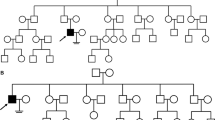Abstract
Purpose
To investigate whether defects in human PRDM9, CDK2 and PSMC3IP are associated with azoospermia Mutational analysis was performed in Japanese patients with azoospermia caused by meiotic arrest.
Methods
Mutational screening of the coding regions of human PRDM9, CDK2 and PSMC3IP was done by direct sequencing using genomic DNA from 18 Japanese patients. Statistical analysis of the detected coding single nucleotide polymorphisms (cSNPs) in patients and normal control men was then carried out.
Results
One cSNP was detected in CDK2 and PSMC3IP. There were no significant differences in genotype distribution and allele frequencies between the patient and control groups in these two genes. However, three novel cSNPs were detected in the PRDM9. The genotype and allele frequencies of heterozygotes in SNP2 and SNP3 of PRDM9 were significantly higher in the patient group than in the control group.
Conclusion
We found a possible association between PRDM9 and azoospermia by meiotic arrest.
Similar content being viewed by others
References
Reijo R, Lee TY, Salo P, Alagappan R, Brown LG, Rosenberg M, et al. Diverse spermatogenic defects in humans caused by Y chromosome deletions encompassing a novel RNA-binding protein gene. Nat Genet. 1995;10:383–93. doi:10.1038/ng0895-383.
Elliott DJ, Millar MR, Oghene K, Ross A, Kiesewetter F, Pryor J, et al. Expression of RBM in the nuclei of human germ cells is dependent on a critical region of the Y chromosome long arm. Proc Natl Acad Sci USA. 1997;94:3848–53. doi:10.1073/pnas.94.8.3848.
Sun C, Skaletsky H, Birren B, Devon K, Tang Z, Silber S, et al. An azoospermic man with a de novo point mutation in the Y-chromosomal gene USP9Y. Nat Genet. 1999;23:429–32. doi:10.1038/70539.
Matzuk MM, Lamb DJ. Genetic dissection of mammalian fertility pathway. Nat Med. 2002;8(suppl 1):S41–9. doi:10.1038/nm0102-41.
Miyamoto T, Hasuike S, Yogev L, Maduro MR, Ishikawa M, Westphal H, et al. Azoospermia in patients heterozygous for a mutation in SYCP3. Lancet. 2003;362:1714–9. doi:10.1016/S0140-6736(03)14845-3.
Nakamura Y, Kitamura M, Nishimura K, Koga M, Kondoh N, Takeyama M, et al. Chromosomal variants among 1,790 infertile men. Int J Urol. 2001;8:49–52. doi:10.1046/j.1442-2042.2001.00242.x.
Sato H, Miyamoto T, Yogev L, Namiki M, Koh E, Hayashi H, et al. Polymorphic alleles of the human MEI1 gene are associated with human azoospermia by meiotic arrest. J Hum Genet. 2006;51:533–40. doi:10.1007/s10038-006-0394-5.
Nasmyth K. Segregating sister genomes: the molecular biology of chromosome separation. Science. 2002;297:559–65. doi:10.1126/science.1074757.
Yoshida K, Kondoh G, Matsuda Y, Habu T, Nishimune Y, Morita T. The mouse RecA-like gene Dmc1 is required for homologous chromosome synapsis during meiosis. Mol Cell. 1998;1:707–18. doi:10.1016/S1097-2765(00)80070-2.
Pittman DL, Cobb J, Schimenti KJ, Wilson LA, Cooper DM, Brignull E, et al. Meiotic prophase arrest with failure of chromosome synapsis in mice deficient for Dmc1, a germline-specific RecA homolog. Mol Cell. 1998;1:697–705. doi:10.1016/S1097-2765(00)80069-6.
Edelmann W, Cohen PE, Kneitz B, Winand N, Lia M, Heyer J, et al. Mammalian MutS homologue 5 is required for chromosome pairing in meiosis. Nat Genet. 1999;21:123–7. doi:10.1038/5075.
Baudat F, Manova K, Yuen JP, Jasin M, Keeney S. Chromosome synapsis defects and sexually dimorphic meiotic progression in mice lacking Spo11. Mol Cell. 2000;6:989–98. doi:10.1016/S1097-2765(00)00098-8.
Kneitz B, Cohen PE, Avdievich E, Zhu L, Kane MF, Hou H Jr, et al. MutS homolog 4 localization to meiotic chromosomes is required for chromosome pairing during meiosis in male and female mice. Genes Dev. 2000;14:1085–97.
Romanienko PJ, Camerini-Otero RD. The mouse Spo11 gene is required for meiotic chromosome synapsis. Mol Cell. 2000;6:975–87. doi:10.1016/S1097-2765(00)00097-6.
Yuan L, Liu JG, Zhao J, Brundell E, Daneholt B, Hoog C. The murine SCP3 gene is required for synaptonemal complex assembly, chromosome synapsis, and male fertility. Mol Cell. 2000;5:73–83. doi:10.1016/S1097-2765(00)80404-9.
Crackower MA, Kolas NK, Noguchi J, Sarao R, Kikuchi K, Kaneko H, et al. Essential role of Fkbp6 in male fertility and homologous chromosome pairing in meiosis. Science. 2003;300:1291–5. doi:10.1126/science.1083022.
Hayashi K, Yoshida K, Matsui Y. A histone H3 methyltransferase controls epigenetic events required for meiotic prophase. Nature. 2005;438:374–8. doi:10.1038/nature04112.
Ortega S, Prieto I, Odajima J, Martin A, Dubus P, Sotillo R, et al. Cyclin-dependent kinase 2 is essential for meiosis but not for mitotic cell division in mice. Nat Genet. 2003;35:25–31. doi:10.1038/ng1232.
Petukhova GV, Romanienko PJ, Camerini-Otero RD. The Hop2 protein has a direct role in promoting interhomolog interactions during mouse meiosis. Dev Cell. 2003;5:927–36. doi:10.1016/S1534-5807(03)00369-1.
Tsujimura A, Takahara S, Kitamura M, Miura H, Koga M, Sada M, et al. HLA-DR antigen and HLA-DRB1 genotyping with nonobstructive azoospermia in Japan. J Androl. 1999;20:545–50.
Acknowledgments
This study was supported by Grants-in-Aid for Scientific Research (No. 19591887 and 20591902) from the Ministry of Education, Culture, Sports, Science and Technology of Japan, and the Ministry of Health, Labour and Welfare of Japan.
Author information
Authors and Affiliations
Corresponding author
Additional information
Capsule The human PRDM9 (MEISETZ) gene might play a critical role in human spermatogenesis.
Rights and permissions
About this article
Cite this article
Miyamoto, T., Koh, E., Sakugawa, N. et al. Two single nucleotide polymorphisms in PRDM9 (MEISETZ) gene may be a genetic risk factor for Japanese patients with azoospermia by meiotic arrest. J Assist Reprod Genet 25, 553–557 (2008). https://doi.org/10.1007/s10815-008-9270-x
Received:
Accepted:
Published:
Issue Date:
DOI: https://doi.org/10.1007/s10815-008-9270-x




